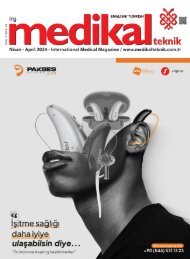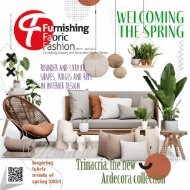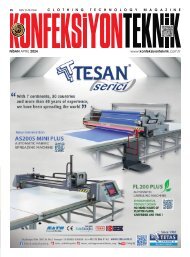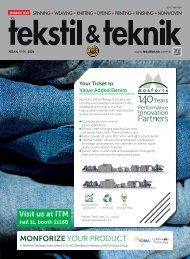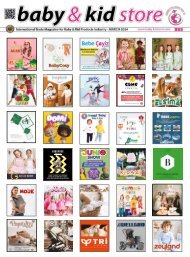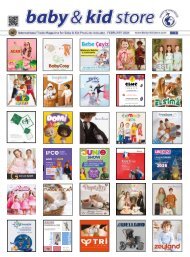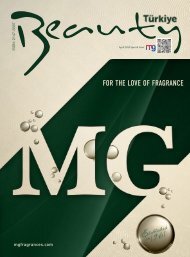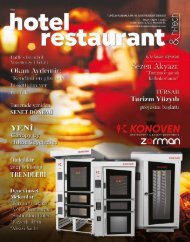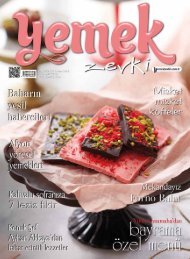Create successful ePaper yourself
Turn your PDF publications into a flip-book with our unique Google optimized e-Paper software.
yaşam için baskı <strong>2018</strong><br />
sense of belonging. He also demonstrated the benefits<br />
of using ferrous media for mounting to magnetic<br />
panels for quick and easy graphic change overs in<br />
retail environments. Xavier continued to review the<br />
stunning opportunities currently available using dye<br />
sub fabric to create continuous walls of seamless<br />
imagery. The key message was that every surface<br />
can be printed on. Antalis have created their ‘Antalis<br />
Interior Design Award’ which received 43,000 visitors<br />
of which 29,000 were unique and received over 300<br />
entries. Antalis also created ‘The Book’ which features<br />
the stories of the winners and the top 50 entries.<br />
Dr. Dieter Holzinger from Tiger Coatings presented<br />
their ink solutions for different décor applications.<br />
Tiger Coatings manufacture water-based UV inks<br />
for single pass printing at speeds of up to 200 linear<br />
metres per minute. These ink solutions are pinned<br />
(part cured) with UV before being exposed to near<br />
infrared energy to remove the water. Afterwards<br />
they are finally cured with mercury vapour UV. In<br />
addition, they make ceramic inks that fire at 600°C<br />
or a UV curing formulation for ceramic and glass<br />
applications on pre-treated substrates.<br />
TIGITAL inks and powders supply inks for paper<br />
laminated prints that bonds to melamine. The new<br />
developments are to print direct using UV inks for the<br />
industrial decoration of the base substrate in flooring<br />
and furniture applications.<br />
UV is superior to 100% water-based because the<br />
immediate cure prevents progressive TVI (tonal<br />
value increase) and cockling. The Hymmen Jupiter<br />
JPT-L single pass digital press prints UV at 40 linear<br />
metres per minute at a width of 2176mm. This series<br />
of digital printing presses have been engineered to<br />
handle industrial volumes of paper to melamine<br />
products that are used across a wide range of<br />
furniture and flooring materials.<br />
For glass imaging the glass must be very clean,<br />
then heat-treated and pre-treated to be receptive<br />
to UV digital inks. The process of digital printing is<br />
generally CMYK and the inks are supplied to a tight<br />
ΔE 0.5 tolerance. The presses are usually calibrated<br />
at the start of each shift and UV provides great<br />
process stability over water-based.<br />
Dr. Marc Hunger from Merck introduced RGB<br />
printing, which sounds strange to most of us. This<br />
technology utilises Merck’s Spectraval pearl lustre<br />
pigments. These red, green and blue inks are either<br />
screen or gravure printed onto a black background<br />
using RGB separations. The end results provide<br />
stunning metallic images in full colour that capture<br />
light and have unique characteristics. However, the<br />
time and testing required to achieve the best results<br />
should not be underestimated.<br />
Atelier Siebdruck in Switzerland are one of the most<br />
able developers of this printing method and have<br />
found numerous applications in the luxury watch<br />
and jewelry markets where the higher costs can be<br />
justified. If you haven’t seen this technique get in<br />
touch with Merck for more details as it is stunning!<br />
Jan Seguda from ColorGATE presented on his topic<br />
of colour deviations in the decorating industry. Jan<br />
described the increasing complexity of imaging<br />
expectations including both colour and texture.<br />
Haptics or the power of touch is important in creating<br />
memorable moments. This is why the demand for<br />
textured effects in digital printing is increasing. He<br />
explained the challenge faced in creating the 3D data<br />
files, this is still an issue where many printers have<br />
to out-source this scanning process.<br />
Jan showed the SURF 3D – Metis 3D surface director<br />
which is ColorGATE’s system for scanning and<br />
capturing materials and design elements in full 3D.<br />
The system is also capable of creating ICC profiles.<br />
The workflow from ColorGATE utilises a proprietary<br />
file, .FPF for integration into their RIP or DFE<br />
software. The system can for example take heavily<br />
grained leather and allows you to replicate it on a UV<br />
flatbed printer with clear then process ink overprint<br />
to create an authentic and effective simulation, that<br />
is very impressive. The system can be used in many<br />
markets where it’s format of 49x32cm (or stitched<br />
to 49x85cm) captures sufficient size objects. There<br />
are several examples of where this technique can<br />
be applied such as textured printed phone covers to<br />
prototyping in the ceramic tile and flooring markets.<br />
Having enjoyed the technical presentations so far, I<br />
decided to move to the creative presentations. I saw



